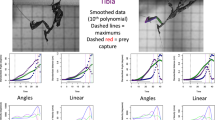Summary
1.The energetic performance and food requirements of female Phillodryas chamissonis was determined during its breeding season at different ambient temperatures. 2. If the long tailed snake is active for 24 weeks, 25 to 32 30-g rodents are required for reproduction and maintenance. This is slightly more than one rodent per week. 3. The energy cost of reproduction (38 to 48% of total metabolism) is close to the values reported for fish (35% of metabolizable energy). 4. Due to their low metabolic rates, the theoretical predation pressure (on a prey biomass basis) exerted by the snakes should be 2 to 2.5% of that expected for endothermic predators of similar body size.
Similar content being viewed by others
References
Avery RA (1982) Field studies of body temperatures and thermoregulation. In: C Gans, FH Pough (eds) Biology of Reptilia Academic Press, London, pp 93–166
Castri F di, Hajek E (1976) Bioclimatología de Chile Editorial Univ Católica, Santiago
Dmi'el R, Borut A (1972) Thermal behavior, heat exchange, and metabolism in the desert snake, Spalerosophis cliffordi. Physiol Zool 34:78–94
Donoso-Barros R (1966) Reptiles de Chile. Ediciones Univ Chile, Santiago
Flehartly ED, Krause ME, Stinett DP (1973) Body composition, energy content and lipid cycles of four species of rodent. J Mamm 54:426–438
Gates D (1980) Biophysical Ecology. Springer, Berlin, Heidelberg, New York
Greenwald OE (1974) Thermal dependence of striking and prey capture by gopher snakes. Copeia 1974:141–148
Hamilton KL (1985) Food and energy requirements of captive barn owls Tyto alba. Comp Biochem Physiol 80A:355–358
Huey RB (1982) Temperature, physiology, and ecology of reptiles. In: C Gans, FH Pough (eds) Biology of Reptilia Academic Press, London, pp 25–91
Jaksic FM, Greene HW, Yañez JL (1981) The guild structure of a community of predatory vertebrates in central Chile. Oecologia (Berlin) 49:21–28
Kitchell JF (1969) Thermophilic and thermophobic responses of snakes in a thermal gradient. Copeia 1969:189–191
McManus JJ, Nellis DW (1973) Temperature and metabolism of a tropical lizard, Anolis acutus. Comp Biochem Physiol 45A:403–410
Morrison PR (1951) An automatic manometric respirometer. Rev Sci Ins 22:264–267
Porter WP, Tracy CR (1974) Modeling the effect of temperature on the ecology of the garter snake and leopard frog. In: Gibbons JW, Sharitz R (eds) Thermal Ecology Oak Ridge, Tennessee. pp 595–609
Porter WP, Tracy CR (1983) Biophysical analyses of energetics, time-space utilization, and distributional limits. In: Huey RB, Pianka ER, Schoener TW (eds) Lizard Ecology: studies of model organisms. Harvard Univ Press, Massachusetts. pp 55–83
Rahn H (1982) Comparison of embryonic development in birds and mammals: birth weight, time, and cost. In: Taylor CR, Johansen K, Bolis L (eds) A companion to animal physiology. Cambridge Univ Press, Cambridge, pp 124–137
Regal PJ (1966) Thermophilic responses following feeding in certain reptiles. Copeia 1966:588–590
Schreiber RK, Johnson DR (1975) Seasonal changes in body composition and caloric content of great basin rodents. A Theriol 20:343–346
Sibly R (1981) Strategies of digestion and defecation. In: Townsend CR, Calow P (eds) Physiological Ecology, Blackwell Scientific Publications, Oxford. p 109–139
Spotila JR Standora EA (1985) Energy budget of ectothermic vertebrates. Am Zool 25:973–986
Stewart G (1965) Thermal ecology of garter snakes Thamnophis sirtalis (Hallowell) and Thamnophis ordinoides (Baird and Girard). Herpetologica 21:81–102
Vinegar H, Hutchison VH, Dowling HG (1970) Metabolism, energetics, and thermoregulation of snakes of the genus Phython (Reptilia, Boidae). Zoologica 55:19–48
Wieser W (1985) A new look at energy conversion in ectothermic and endothermic animals. Oecologia (Berlin) 66:506–510
Author information
Authors and Affiliations
Rights and permissions
About this article
Cite this article
Bozinovic, F., Rosenmann, M. Energetics and food requirements of the female snake Phillodryas chamissonis during the breeding season. Oecologia 75, 282–284 (1988). https://doi.org/10.1007/BF00378610
Received:
Issue Date:
DOI: https://doi.org/10.1007/BF00378610




